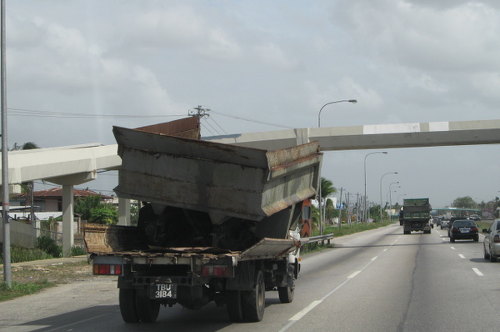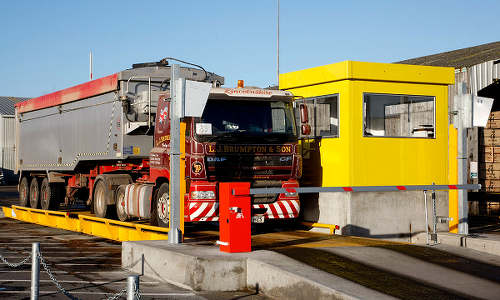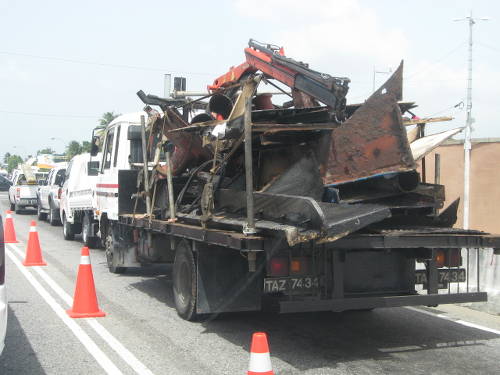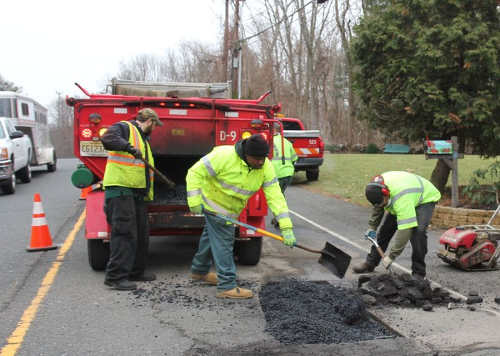“Hauliers of aggregates and hardware material often install a ‘greedy bar’ in order to extend the truck’s capacity beyond the stipulated maximum gross weight.
“The ‘greedy bar’ is removed whenever the truck has to be inspected by the Licensing Authority.”
The following Letter to the Editor, which deals with aspects of the new Road Traffic (Amendment) Bill, was submitted to Wired868 by traffic and transportation engineer Dr Rae J Furlonge:

Road vehicle weight limits are not enforced in most Caribbean countries. That is due to several factors, such as opposition by truckers, the lack of understanding of the precise effects of overloading on the deterioration of road surfaces, lack of political will and an insufficient number of available vehicle weighing scales.
Even if legislation is enforced, the low fines plus the fact that the truckers are allowed to proceed after paying the fines will not ensure that axle load limits are observed. The net effect on the road network is premature failure of the roadway pavements and an increase in the maintenance budget. These costs are not usually borne by the road users responsible for creating the problem.
Roads are designed to accommodate a projected number of axle load repetitions of a specific magnitude for a projected service life. The damage created by traffic loads is expressed in terms of a reference axle load.
Projected axle loads from different vehicle configurations are converted into an equivalent number of 8,000-kg single axle loads. These equivalent single axle loads (ESALS) are the basis for determining the thickness of the road structure required to provide the desired design life and thus its cost.
The effect of a single axle load on a road increases by about a fourth power of axle load. For example, although a 16,000-kg single axle load is only twice as large as an 8,000-kg single axle load, it causes 17 times more loss in the life of a road.

(Copyright UK Telegraph)
In addition to the impacts on road service life, increasing axle loads may also increase the level of maintenance required between major resurfacings. As expected, using tandem axles rather than single axles reduces the damage to the pavement.
Very few of the Caribbean countries can give evidence of: (a) the extent of overloading, that is, how many vehicles are carrying loads beyond the maximum vehicle and axle limits, (b) the categories/classes of these vehicles and types of cargo being carried, (c) which routes and road links these vehicles are using, and (d) the degree of overloading by each category/class of vehicles, that is, the percentage of overloading of each category/class of vehicles.
Implementing an effective vehicle weight control programme is impossible in the absence of this data and so, without it, proper management of routine road maintenance becomes quite difficult.
With respect to vehicle overloading, the following are specific concerns as regards the Trinidad and Tobago Motor Vehicles and Road Traffic (Amendment) Bill, 2017:
- The changes to Section 97(2) and 98(1) constituted mere editing. Vehicle overloading also appears in the original Act in section 23, and the current amendment addresses only sub-section 23(1) (d) concerning window tint. So why such minor amendments to what is a critical matter of vehicle overloading?
- Section 97(1) of the existing Act directs the vehicle or trailer to the nearest weighbridge for the purpose of weighing its load. Which weighbridge of the Licensing Authority is operational?

(Copyright Weightron.com)
The 1994 Weigh-in-Motion Study done by Lea-Trintoplan on behalf of the Ministry of Works and Transport, Government of Trinidad and Tobago showed that there was a significant amount of vehicle overloading on the nation’s roadways.
The incidence of overloading was greatest on the Churchill-Roosevelt Highway, the Uriah Butler Highway and the Eastern Main Road in Valencia. The main offenders were semi-trailers with three or four axles, closely followed by straight trucks with double wheels on the rear axle.
Hauliers of aggregates and hardware material often install a “greedy bar” in order to extend the truck’s capacity beyond the stipulated maximum gross weight. The “greedy bar” is removed whenever the truck has to be inspected by the Licensing Authority.
- In the T&T Parliament, Faris Al Rawi, the Honourable Attorney General, referred to the Jamaica example; let me refer to Jamaica a bit. Jamaica has given priority to the control and enforcement of vehicle overloading. What is the extent of their overloading?
- As was the case in T&T, the number of heavy vehicles in Jamaica doubled over the period 1994-2006.
- The typical truck is at least 65% overweight—quite a number of units are carrying twice the legal axle loads. This causes in excess of 10 times the damage done by a vehicle carrying legal axle loads and cuts in half the life of the roadway based on design loads.

Several years ago, Jamaica established a four-man Vehicle Weight Enforcement Unit at the Island Traffic Authority (ITA):
- The Unit has received hands-on training on AX900 Portable Scales.
- A Comprehensive Vehicle Weight Enforcement Manual has been developed
- Two (2) portable weigh scales have been procured
Several improvements have been proposed to the existing regulations in Jamaica:
- An increase in the sum payable as a penalty for breaches or violations of the law.
- The person in charge of the vehicle shall ensure that another vehicle is dispatched and the excess goods be off-loaded onto another vehicle in a manner not likely to cause obstruction to the traffic and the offending vehicle or trailer shall not proceed until it has satisfied the prescribed weight limit.
- “The ITA may, after seven (7) days, dispose of non-perishable goods stored [removed from overloaded vehicles] by means of sale or such other manner as it thinks fit. For perishable goods, the ITA may sell or otherwise dispose of them before the seven (7) days.” The ITA does not want to get into the storage and vending business.
- Axle configuration details to be put into regulations
- No objection to varied license fees favouring increased axles but max vehicle length of 17.3m must not be exceeded

- I have recommended that:
- permanent weight-restricted bridges be placed at the terminal gates of all ports in order to address container truck overloading;
- the Licensing Authority acquire portable weigh bridges and;
- vehicle weight regulations be enforced in a consistent and effective manner. This enforcement should be highly visible in order to serve as a deterrent, a warning and/or a reminder to others.
 Wired868 Wired868 for smart sport news and opinion
Wired868 Wired868 for smart sport news and opinion










Garth St. Clair in the big nations they used 20/20 vision and catered for that problem by placing most of the lines on the sidewalks so the roads donot have to be damaged in order of repairs to pipelines so our engineers of 50 and 60 yrs ago was not thinking all those ideas now the populations of today has a never ending issue with roads repairs when pipelines go bad or needs repairs
All this talk and nothing will be done to regulate and penalize these abusers. Road tax ….? They owe every single car owner an apology and maintenance costs for a year
Tee Siwel
Also when the roads flood the water washes away part of the patched paving.
I think we should sue them for damages
Wired868 the above article is complete rubbish, trucking rules and regulations should be advised by person with a level of education on the matters. The load capacity by the “greedy bar” isnt damaging the roads, the damage is done if weight is exceeded. For instance some material such as sand can be load in half of a tray but when wet is heavier than an equally greedy bar tray. Addition of more axles help spread the weight to great protect our roads but are also denied by transport boards locally. Weigh stations are bad ideas for us locally as it would involve the drivers going off route with suspicion of overload when the term isnt even clarified. Weight scales such as DOT in the USA is a much better idea check weights on the spot. People target trucks but we deliver every item in your household including the house. The angle we should aim to regulate is build our infrastructure to handle a designated weight and maintain a standard axle capacity while inspecting at random. When you place sand as a foundation for the artery that is our highway without any retaining wall or bracing what else can you expect. Trucks are forced to driver on improper roads suffer suspension damage impacted by effects of poor diesel high in sulphur. If you all dont care for the trucking industry be forced to feel the effects without it! Look at the picture from all angles. Do you all know what weight is suitable on our roads? No! Because its based on the axles spread! Can it be regulated no because alot of the roads hve little to no foundation!
There are huge trucks all over the world. 18 wheelers and counting. The trick is, building, and I stress on the word building the roads to cater for trucks. In a small country as ours, there is no money to be made “building” roads. When there are pipes to be repaired in the UK, US and Canada, engineers must supervise the “cutting” of the road. In T&T it just requires digging. Wink wink!
What also needs to happen is that these trucks of obvious weight should be regulated to only a lane on the Highway and when entering cities or suburb areas should be offloaded onto smaller vehicles also at a certain regulated weight. This will also stop the continuous disturbance of Water pipes that are also always being destroyed by heavy vehicles on the roadways
Can these people be charged from photos exhibiting illegal use?
But in T&T there is no working weighbridge. So how can we check?
Hmmm SMH
Plenty ignorant ppl willing to expose their stupidity thru coment
Roadways endure heavier usage and wider temperature ranges in more extreme conditions .
Why??
Comes down to construction and maintenance.
Might as well blame roadways for reckless driving and accidents
Hmmm

Hi Hypocrites driving hilux and rangers and them kinda thing :s
That’s a stretch. That would show that our roads were not built properly.
Averil St Clair-Celestain……not a stretch
He’s just dumb
Interesting !!
I’ve always advocated the banning of ten wheeler dump trucks.
Actually multiple axles cause less road damage. But those trucks should only be on primary arterial roads.
Poor road construction is the root cause
SRC was formed to correct all this
NAR shut that down so padnahs could get paving contracts
Some superior bullshit here
Apart from the fact the road makers and repairers dont know what they’re doing.
The worst abuse of the roads is by the oil companies who use massive trailer trucks – first to take their huge 30 ft. pipes and equipment for storage in Chaguaramas , then later, send the trailer trucks to Chaguaramas to collect the pipes and equipment to transport to La Brea – a job that was carried out with the use of barges previously! Transport by sea is the better option as this would do no damage AND would save us the regular traffic jams on our roadways – the equipment was so high that they even tore down the electricity lines close to the entrance to Goodwood Park! This is very easy to put a stop to if the Highways Division was really serious! While the Oil Companies are saving money by transporting by land, our roads are destroyed AND the cost of maintenance borne by Taxpayers – not to mention our Productivity!!!
Hmm. Very good point Annette.
Ten wheeler dump trucks should be limited to highways and main/ primary roads not secondary and rural roads.
Correct.
U fix d rds but it cant take dem huge trucks wat u expect .time to enforce laws to deal wit trucks overweight on d nation road
I totally agree! Our roads were not designed for these huge trucks. Furthermore some truck drivers drive on roads that they are not supposed to as per their regulations.
Dr. Furlonge, please permit me to say, that in addition to outlining some facts, yuh talk plenty shit.
Mayfield East in Valsayn North. A mansion is being built and the road is being destroyed on a daily basis by the trucks.
Ah, did he mention the contractors who give us a 6 for a 9 as well?
It is so shameful for a country that owns a Pitch lake
Wow this is so interesting. Was this article in any of the newspapers?
Newsday Business. Look where.
Ahh. Ok
You need to urge residents to stop burning debris on the roads as this damages the asphaltic surface also.
Very enlightening article.
Well here WASA Trinidad & Tobago does always dig the road and leave it in a mess. Like it hurts them to see a smooth road
And it’s only after the road is paved, they digging… Check it out….
That explains it
Not only that
It have rusting ole age vehicles being used to haul loads around the country
Some vehicles need to be “confiscated ” by the police and sent to a junkyard
Lasana wired868 is fast becoming my only source of interesting and thought provoking discussions.in Trinidad and Tobago. Enjoying the range of topics and writers. Really well done. Kudos
Thanks Jason! And thanks for sharing with us Rae Furlonge.
I concur Jason
Lasana Liburd you have to also add the fact that in some cases our roads are not built to design. Some “Road Paving” companies get away with murder.
Corruption and incompetence all around.
I heard the paving grade doesn’t meet the standard
To save money they cut back on aggregate hence the road warps in hot weather
Example by valsayn junction
Kyon Esdelle, I understand that fibre/concrete can be used to make road hold up to weight of new vehicles and weather.
Our poor drainage on roadways also plays a part.
Asphalt is suppose to be under roads not the surface lol lol
It’s really a waterproofer not suppose to be the road
So what you trying to say? Our road engineers don’t quite know what they doing? (I have my suspicions lol).
Cost savings
Even more than the actual tender
What’s new with our completely dysfunctional government.
Is it that the administration or the people are dysfunctional?
Both probably. Dysfunctional people get a dysfunctional administration.
… correction…dysfunctional people dysfunctioning in dysfunctional systems form dysfunctional administrations
As for the “greedy bar” that name alone tells a whole story. About standards… Does ANYONE even bother to apply quality controls? With the state of the local construction industry, for the most part, the circle of industry players seems more interested in doing just “enough” to serve the payment cycle rotation.
The writer gives some valuabe insight here…
“Road vehicle weight limits are not enforced in most Caribbean countries. That is due to several factors, such as *opposition by truckers*, the lack of understanding of the precise effects of overloading on the deterioration of road surfaces, lack of political will and an insufficient number of available vehicle weighing scales.
Even if legislation is enforced, the low fines plus the fact that the truckers are allowed to proceed after paying the fines will not ensure that axle load limits are observed. The net effect on the road network is premature failure of the roadway pavements and an increase in the maintenance budget. These costs are not usually borne by the road users responsible for creating the problem.”
Lasana
Great article as usual
These 10 wheeler trucks have permission from the Licencesing Authorities to travel on stipulated routes but are often seen on many secondary roads adding to further destruction from their excessive weight.
So, what does quality control on the road have to do with overloaded trucks?
What about HONOR PRINCIPLED LIVING?
The CHARACTER of a man is not determined by what he does when people are looking, but rather by what he does when he’s alone.
Having to add the level of QC that you are alluding to only increases the cost of the project.
Won’t it be simpler for all involved to live and interact honorably?
As for a dysfunctional system, a system cannot exist without the prerequisite elements. Therefore it’s only the elements which can be described as dysfunctional.